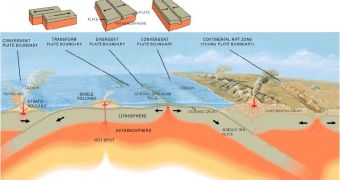Scientists with the French research agency CNRS in Paris, led by group leader and geophysicist François Pétrélis, have determined that plate tectonics may be responsible for the swapping of magnetic poles over intervals of millions of years.
Plate tectonics is a term used to describe the slow and intricate interactions that occur between oceanic and continental plates, on which everything on the surface of the planet lies. There are several large plates, such as the one holding the Pacific Ocean, as well as countless smaller ones.
Their interactions are regulated by the planetary mantle, a layer of molten rock located beneath the crust and Earth's outer core. Convection currents stir this mixture, creating eddies and swirls that force tectonic plates above to bump into each other.
Another significant influence comes from mid-Atlantic ridges, where new crust is being formed at a constant pace. This phenomenon pushed Eurasia and Africa away from the Americas, increasing the size of the Atlantic Ocean, and reducing the size of the Pacific Ocean on the other side of the planet.
The Pacific Ring of Fire, a string of volcanoes spanning the western coasts of the Americas, Australia, New Zealand, Japan and eastern Asia, is the name given to areas where tectonic plates are pushed into each other. These events are the source of earthquakes and tsunamis, as well as volcanic eruptions.
Now, the French team proposes that these interactions are also responsible for magnetic pole reversals, phenomena that have been known to happen throughout Earth's history. These events leave clear marks in the geological record, which experts can then analyze, Science News reports.
“What we see clearly is that the surface positions of the continents are linked with the frequency of the reversals,” Pétrélis explains. He and his team will publish their conclusions in an upcoming issue of the esteemed scientific journal Geophysical Research Letters.
Other research teams have taken this discovery with a grain of salt, noting that many more studies are required to validate such a link. However, the idea itself is very interesting, and definitely worth examining in detail.
Even though the latest flip occurred about 780,000 years ago, the one before that took place tens of millions of years before. What this means is that no clear pattern can be discerned from available readings. This could represent a thorn in the new theory.

 14 DAY TRIAL //
14 DAY TRIAL //